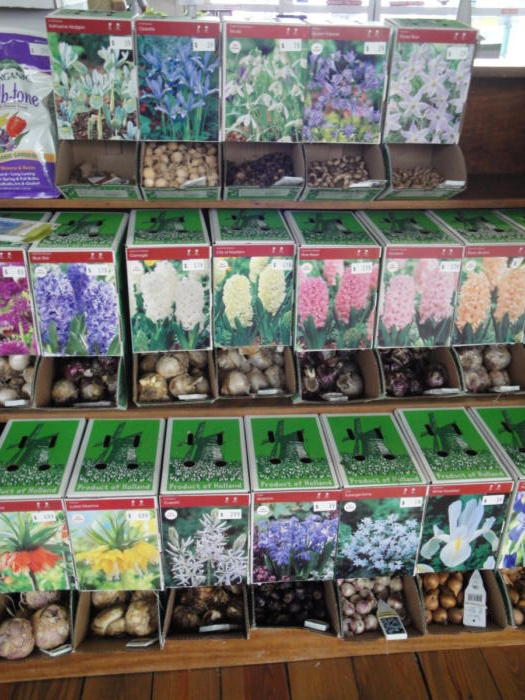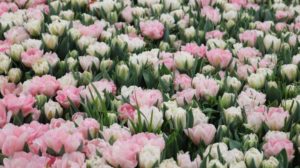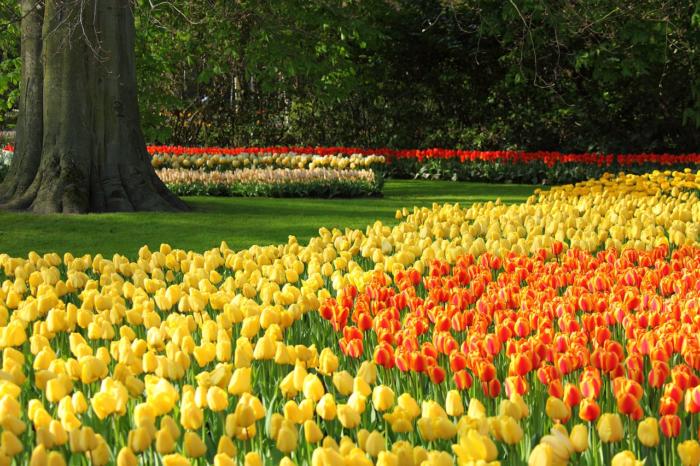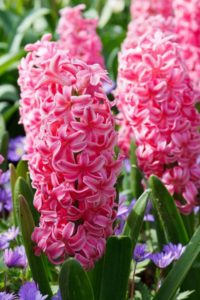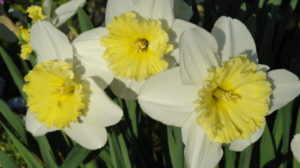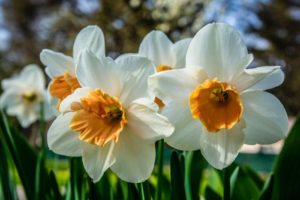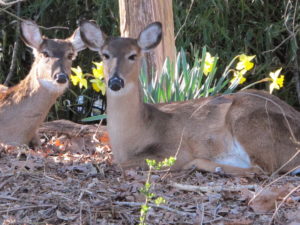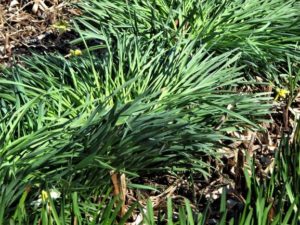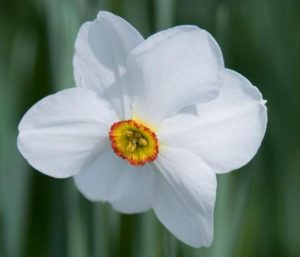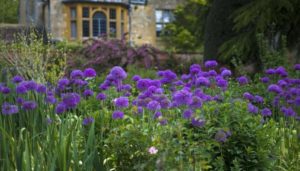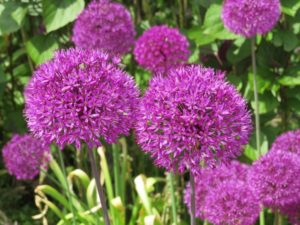Page 4
Hyacinthoides
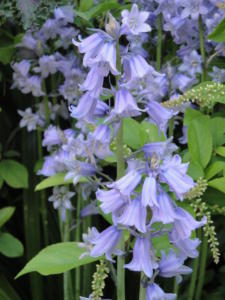
Wood hyacinth (Hyacinthoides hispanica) blooming with Virginia sweetspire (Itea virginica).
This group of bulbs has been suffering from an identity crisis for decades. Sometimes called Scilla, sometimes Endymion, even its common names have been listed variously as Bluebells, Spanish Bluebells, and Wood Hyacinth. The taxonomists seem to have settled on the name currently appearing in catalogs: Hyacinthoides hispanica, the wood hyacinth.
Wood hyacinths like rich, moist soil, and prefer light afternoon shade in hotter areas of its range (Zones 3-8). Bloom spikes, 14″ to 18″ tall, rise above thick clumps of long narrow leaves. They can be found in separate pink, blue, and white flower colors, or as a mixture.
These plants are deer and rodent resistant. They’re perfectly suited to open woodland plantings, where clumps can assume substantial proportions. Or plant several bulbs in a mulched bed under the oak tree or in front of the rhododendrons. Easy.
English wood hyacinth (Hyacinthoides non-scripta) has deep blue bell-shaped flowers on one side of the 18″ tall stem. This one likes a more moderate climate (Zones 5-7).
There are some spring-flowering bulbs, such as this one, whose top end is difficult to distinguish from the bottom end. If in doubt, plant the bulb on its side. The roots and stems always know which way to grow.
Tulipa
Few things were more predictable than the bold, bright yellow and red ‘Emperor’ tulips that came up every year in my parents’ New Jersey garden. They’re a wonderful sight where colder weather prevails, and usually return annually.
Tulips are stunning in mass plantings, but even a dozen bulbs will make an impressive display close to the front door or in a clump along the sidewalk.
Avoid spacing them single-file. Depth of color provided by a few layers of bulbs shows up better. Plant them in clusters between shrubs, among the perennials, or in display gardens that are changed out a few times through the year. I know of many gardeners who plant hundreds or thousands of them!
Most of the species and Kaufmanniana types are small-growing, from 4″ to 10″. Parrots, Triumph, and Bouquet tulips are generally 14″ to 18″ tall. And the Darwins and Fringed groups can reach 24″ to 30″ tall. The foliage of Greigii varieties (8″ to 20″ tall) is beautifully streaked in a contrasting color.
Research the different groups of tulips before investing in a large planting, noting height, color, season of bloom, and heat tolerance. And don’t forget the deer and vole repellents!
Tulips can be cut at the closed bud stage of growth, and displayed indoors as a bunch by themselves or in a cottage mixture of wildflowers, twigs, and greens.
Tulips In Zones 7 and South
As finicky as tulips are here in the warmer southeast U.S., you can still expect a fabulous display the year after the bulbs are planted. In order to have a spring garden of tulips in or south of zone 7, there’s some preparatory work to be done first.
After purchasing large, healthy bulbs, place them in paper bags, and keep them in the refrigerator. Label them if you want to keep track of their colors or cultivars. The temperature should run 40° to 45°F. Also, remove all fruits from the refrigerator, as they give off ethylene gas which could damage the dormant flowers. Keeping a separate dorm size refrigerator for this purpose could simplify things.
Chill the tulips for about 12 weeks. In the meantime, start preparing the bed for your tulips some time in December. Secure plastic sheeting over the prepared bed to prevent the soil from freezing.
After the cold treatment, plant the bulbs at the proper depth and without delay. Even a short period of time in warm temperatures could signal the tulips to bloom prematurely. After planting, mulch the bed to keep the soil consistently cold.
When they emerge in late winter, protect tulips from deer, enjoy the blooms, but don’t expect an encore presentation the following spring. Maybe a few will bloom again.
If You’re Up for a Challenge…
…and want to try keeping the bulbs, fertilize with a complete bulb fertilizer at peak bloom. Cut off any seedpods trying to develop, but keep all leaves on the plants. They need to make as much food as possible to feed the bulbs.
When all the foliage has turned brown naturally, pull up the tulip plants, and let the soil dry in a frost-free but cool area. Snip off the dead growth, remove most of the soil, and store the bulbs in a cool place. Large bulbs have the best chance of growing through another cycle.
Then start the refrigeration process all over again in autumn. I’ve never tried to rebloom tulips, so I can’t say it’ll work.
Why Tulips Refuse to Return
Enjoy the blooms while they last. Warm temperatures and wet soil cause bulbs to deteriorate; that’s why most tulips don’t perennialize south of zone 7.
When temperatures drop below the mid 50’s, a biochemical process in the bulb changes the stored carbohydrates into glucose. This glucose acts as an antifreeze, preventing tulips planted in the cold ground from freezing. So, they can take the cold.
Check with bulb specialists to see which cultivars will perform better in your location. I’ve grown some of the species tulips successfully for years, without replanting, in the Maryland zone 7 garden.
Species Tulips
John Scheepers’ Beauty from Bulbs catalog lists about two dozen species tulips. I’ve grown many over the decades, and enjoyed all of them. They’re generally small growing, perfect for rock gardens or tucked in here and there. Plant them along pathways, so you can view them up close, where you can appreciate the patterns of contrasting colors inside the flower.
Tulipa humilis alba caerulea oculata (Zone 3-8) is a white flowering, 5″ tall tulip with an incredible steel blue patch in the bottom the cup. There are many bicolors, including T. ‘Peppermint Stick’ (Zone 5-8) with a red and white exterior, and T. saxatilis (Zone 5-10), a more heat tolerant species with lilac-pink petals with a yellow base. Check the catalog listings; many species tulips will grow better in warmer climates than their larger cousins.
Tulipa biflora, batalinii ‘Bright Gem’ and ‘Salmon Gem’, bakeri ‘Lilac Wonder’, sylvestris, dasystemon, humilis ‘Helene’, linifolia, ‘Little Beauty’ and ‘Little Princess’, clusiana var. chrysantha, turkestanica. All of these are hardy from Zone 4 or 5 south to Zone 8.
Hyacinthus
No one (okay, few) can walk by hyacinth flowers without stopping to take in the intoxicating fragrance. Hyacinthus orientalis (Zones 4-8) needs well-drained soil; the large bulbs can rot in wet soil. Plant summer annuals over the hyacinth bulbs to help dry the soil. Deer are sometimes fond of the flowers, so use a deer repellent. Fortunately, established hyacinths usually have a second flower bud, and sometimes a third, in the line-up.
Hyacinths come in just about every color of the rainbow: ivory white, primrose yellow, salmon, pink, pinkish-red, and several shades of blue and purple. Readily available varieties include ‘Aiolos’, the new pale ‘Yellowstone’, ‘City of Haarlem’, ‘Gypsy Queen’, ‘Pink Pearl’, ‘Fondant’, ‘Jan Bos’, ‘Woodstock’, ‘Miss Saigon’, ‘Delft Blue’, ‘Blue Jacket’, and the double flowering ‘Royal Navy’.
The ‘Festival’ Multi-Flowering series has flowers in blue, white, and pink, but the florets are not as densely clustered as they are in the other hyacinths.
We plant several more bulbs than the garden needs, because now and then one will come into the house as a cut flower. Just one flower stem will fill the room with the scent of springtime! Some find the scent cloying; others…delightful. Cut the flower before it has fully opened, and keep it indoors for a few days, or until the scent goes a bit musty.
For casual gardeners who object to the rigidly formal appearance of the first year’s flowers, there’s no need to worry because the blooms in subsequent years will adopt a more open structure. Hyacinths in good soil and in good sun can return for many years…a good investment.
Narcissus
Buying Daffodil Bulbs
New gardeners are more likely to have the showiest results from daffodils (Narcissus varieties) than from any other bulb. Daffodils make a beautiful display, and their flowers are substantial. Better yet, they’re deer-proof!
As long as healthy bulbs are planted in well-drained soil, full sun, or sun most of the day (when they’re in leaf), and at the proper depth, success if guaranteed. A healthy bulb feels firm when gently squeezed and has no rotten parts.
I recommended buying the bulbs as soon as they arrive at the garden centers. And plant them as soon as possible, because they begin to dry up and soften if left on the shelf too long. Autumn is the time of year when they want to be rooting out and absorbing water.
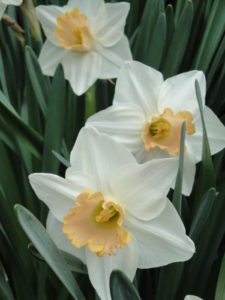
Narcissus ‘Salome’, a pink-cupped daffodil. The cup opens peachy-yellow and matures to apricot-pink.
Look for large bulbs. Bulbs of dwarf daffodil cultivars will be smaller than those of the large growers. They are often sold as DNII or DNIII bulbs, “double-nose 2” or “double nose 3”. These multiple-nosed bulbs are older and have more flowering potential than small single-nose bulbs. Bulbs that have only small bulblets (noses) might not flower the first season, so look for the ones that have at least one large bulblet.
They also cost more than the bargain-priced bags of unnamed “yellow” or “white” daffodils. Considering the fact that they can live for many years, paying a little more for named varieties from reliable suppliers is worth the price if you want to establish another garden using the same cultivars, or if you like knowing what the colors will be and when they bloom.
The economy-priced bulbs will probably flower fairly well. Eventually, they will gain vigor and catch up with the DNII’s. They’re fine if you don’t need to know the varieties by name.
The bushel-quantity collections and themed mixtures (all white, all fragrant, all split-cup, for example) sold by reputable bulb producers are often well-priced and comprise DNII bulbs.
Which Will You Choose?
There are so many varieties of daffodils to choose from. The flowers consist of an outer row of petals called the perianth. In the center is the cup, or corona, also called the trumpet. Colors are pure white, ivory, all shades of yellow, amber, apricot, salmon, pink, shades of orange, green, and some with touches of red.
Flowers can be solid colors, the corona can be a boldly contrasting color, and some have coronas that are edged in a different color. There are soft pastels, and others scream loudly for attention.
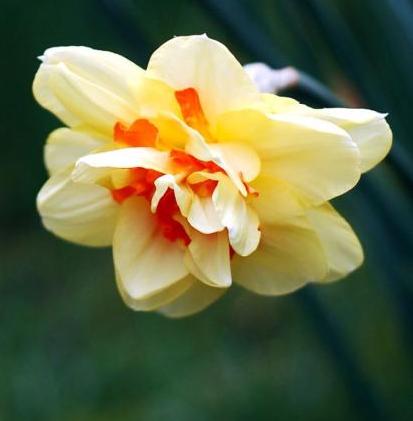
Petals might reflex, or curve backward. Some daffodils have a wonderful scent, others have multiple flowers on a stem, some have a “split cup”. There are single flowers with 6 petals in the perianth, and others have double or triple the usual number (photo, above).
Cute and early ‘Tête-à-Tête’ blooms at about 6-8″ in height; ‘Mount Hood’ and ‘Salome’ grow to a lofty 18″ to 20″ tall. The lovely fragrant ‘Bell Song’ is 12″ to 14″ tall.
Linnaeus, The RHS, and The ADS
Linnaeus described the genus Narcissus, from Europe and Northern Africa, in “Species Plantarum”, in 1753. A few species are planted to this day, but cultivars far outnumber the species offered for sale. And from the 50 or 60 species found in the wild, there are more than 25,000 registered varieties to choose from!
In 1975, The Royal Horticultural Society devised a system of classification for this huge and diverse genus of plants by assigning a Division number to each cultivar. Dr. Tom Throckmorton, daffodil breeder and former president of the American Daffodil Society, is credited with cataloging cultivars on the internet. He contributed a color-code system, recognized by the RHS, to further distinguish one registered cultivar from another.
For example, the ‘Martha Stewart’ daffodil is listed with the code “1 W-WWP”. This variety is in Division 1 (large-cupped daffodil). The first W represents perianth color, so the outer petals are white. The next W is the color of the eye (often not listed, unless the trumpet is multi-colored), again white. The third W is the color of the trumpet, and P indicates the pink rim of the trumpet. Simply put, the initials refer to color from the outer to the inner parts of the flower.
Planting Daffodils
Generally, plant spring-flowering bulbs into the ground at a depth 3 times their height. If a daffodil bulb is 2 1/2″ tall, the bottom of the bulb goes 7 1/2″ to 8″ below the surface of the soil. That seems very deep, but, with good soil preparation, the bulbs will prosper for many years. In soil that I’ve prepared, large bulbs go 9″ deep.
Here’s a common complaint with daffodils: they have lots of leaves in spring, but no flowers after a year or two. This can be caused by:
- lack of sunlight
- cutting off the leaves before they have started to yellow naturally, “starving” the bulbs
- shrubs crowding them out
- planting the bulbs too shallowly
- soil with poor fertility or tilth
The remedy is to dig up the clumps of bulbs after the leaves have yellowed at least halfway from the tip, being careful not to pierce the bulbs. At that time, the bulbs are entering dormancy for the summer. Separate the undersized bulblets. Then replant them in more favorable conditions, pointed end up, into prepared soil at the proper depth.
It might take a couple of years for the blooms to return, so be patient. Fertilize lightly in autumn and in spring to help them along.
Bulb planters make the job easier. A short-handled planter with a long cylindrical blade removes a core of soil. Dig two cores for large bulbs instead of trying to squeeze them into tight quarters. I use a long-handled, long-tubed planter with a step-on flange; it digs a 9″ core. Plant the bulb, and gently replace the core of soil upside-down. This gets some of the richer topsoil closer to the bulb, and the subsoil near the surface, where it will improve over time.
Fragrant Daffodils
- ‘Actaea’ (tolerates more moisture, white with yellow cup, red rim)
- ‘Baby Moon’ (dwarf yellow, late)
- ‘Bell Song’ (white, pink cup)
- ‘Canaliculatus’ (heirloom)
- ‘Canary Bird’
- ‘Carlton’ (large yellow, strong grower, used in mass plantings)
- ‘Cheerfulness’ (double white with yellow center)
- ‘Chinese Sacred Lily’ (brought to U.S. by immigrants in the 1800’s)
- ‘Geranium’
- ‘Golden Echo’ (white, yellow cup, yellow spreads to perianth)
- ‘Hawera’ (small flower, canary yellow)
- ‘Minnow’ (dwarf, white, light yellow cup)
- ‘Peeping Jenny’ (ivory, long yellow cup, long-lasting flowers)
- ‘Pipit’ (long-lasting, lemon yellow, cups turn ivory)
- ‘Replete’ (large double, white and pinkish-coral)
- ‘Sir Winston Churchill’ (double ivory with orange-red heart)
- ‘Tête-à-Tête’ (dwarf yellow, early)
- ‘Yellow Cheerfulness’ (sport of ‘Cheerfulness’, double primrose yellow)
Check with bulb suppliers for cold hardiness.
Paperwhites
Most of the fragrant paperwhite Narcissus bulbs are hardy in warmer zones of the United States. For northerners, paperwhites grow around the winter holidays, and are composted afterward.
Allium
Here’s another large group of flowering bulbs, which, like daffodils, are animal-resistant. They are related to onions and garlic. Alliums need very well-drained soil with close to neutral pH. Add lime to the bed if your soil is acidic.
Alliums are upright and lend an architectural air to a garden with their spherical flower heads held on strong stems. Flowers are white, pink, blue, purple, and yellow, and range from the 1″ to 2″ wide A. azureum to the massive 10″ wide A. ‘Globemaster’ and the more open 12″ A. schubertii.
The flower heads are often ornamental after the flowers have withered, and can be used in dried flower arrangements. Or enjoy them in the garden for a while.
Grow alliums in full sun, although a few, such as A. oreophilum and A. siculum bulgaricum, will tolerate some shade.
Headings
Page 1: Time For Spring Flowering Bulbs, On the Subject of Tulips, How Bulbs Work, and First, a few words on summer- and fall-blooming bulbs (Elephant Ears, Caladium, Amaryllis, Colchicum Autumnale, Fall Crocus)
Page 2: Color Effects, Formal and Informal, Naturalizing in Lawns, Naturalizing in Meadows, If You’re New To Spring-Flowering Bulbs, When Planting Drifts of Bulbs (Microclimates and Timing, Laying Out the Beds), and Aftercare
Page 3: Galanthus, Crocus (Snow Crocus, Giant Dutch Crocus), Eranthis, Muscari, and Puschkinia
Page 4: Hyacinthoides, Tulipa (Tulips In Zones 7 and South, Species Tulips), Hyacinthus, Narcissus (Buying Daffodil Bulbs, Linnaeus, the RHS, and the ADS, Planting Daffodils, Fragrant Daffodils), and Allium
Page 5: Maintenance, Tricks to Hide Maturing Foliage, Stinzenplanten, Forcing Spring-Flowering Bulbs, Rock Gardens, and Don’t Overlook the Little Ones
